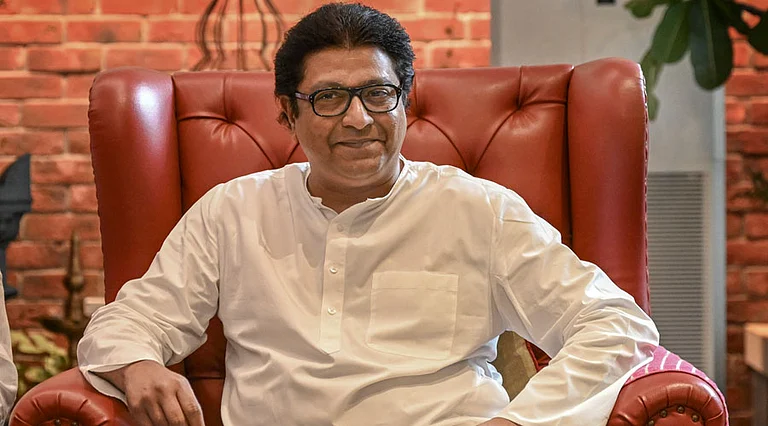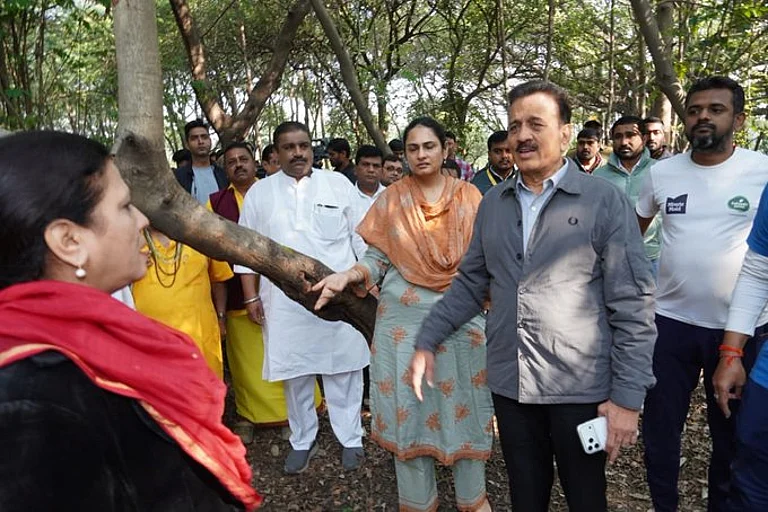Kumbh Mela is the largest human gathering in the world. While much is spoken about its cultural and spiritual significance, Kumbh is equally fascinating as a study in spontaneous economic systems. Kumbh occurs every few years at four rotating locations in India—Allahabad (Prayagraj), Haridwar, Ujjain and Nashik, with the 2019 Prayagraj Kumbh attracting a record 24 crore visitors. The scale of Kumbh, especially in modern times, offers a unique insight into the economics of large-scale, transient gatherings. On a peak day with 3 crore visitors, the Kumbh economy can rival the size of cities like Delhi or Mumbai.
Temporary megacities are created to accommodate crores of visitors, only to disappear after the event concludes, mirroring the creation and dissolution of a mandala—a sacred circle in Hindu and Buddhist traditions symbolising the universe’s impermanence. At Kumbh, as in a mandala, everything appears, serves its purpose and then disappears, relying on an intricate network of stakeholders, each playing a unique role in maintaining this temporary economy.
Kumbh’s stakeholders include government bodies, police and security forces, religious organisations, pilgrims and private businesses. Together, they contribute to the transient economy that emerges during the mela.

The government plays a crucial role in planning, coordination and maintaining public infrastructure. Central and state governments, alongside local municipalities, collaborate to provide essential services such as sanitation, crowd control, public safety, transportation, and healthcare. This requires a massive logistical effort, especially during peak days when crowds swell to nearly 3 crore visitors. While government bodies are heavily involved, private businesses form the backbone of the Kumbh economy, offering essential services. Private tents for accommodation, eateries serving a wide variety of meals, transport services and vendors selling memorabilia, religious books, and daily essentials are omnipresent during the mela.
Temporary megacities are created to accommodate crores of visitors, only to disappear after the event concludes, mirroring the creation and dissolution of a mandala—a sacred circle in Hindu and Buddhist traditions symbolising the universe’s impermanence
These private businesses range from large, formal enterprises operating through government contracts to informal, uncontracted vendors who spontaneously set up stalls. These informal vendors play a crucial role in filling the gaps left by formal stakeholders, catering to niche demands that larger companies may not be able to anticipate or quickly address. Informal vendors also create job opportunities for locals, who come from diverse socioeconomic backgrounds. Their agility allows them to meet the immediate needs of visitors, contributing to a spontaneous yet efficient ecosystem.
The goods and services offered at Kumbh span a full spectrum. Some of the primary economic activities include:
Accommodation Services: From luxurious tents set up by formal companies to makeshift huts offered by smaller vendors, accommodation at the mela caters to all economic strata. Temporary tent cities spring up to accommodate lakhs, with some pandals as big as for 20,000 pilgrims, with thousands others with amenities like wi-fi, hot water and other “luxury” facilities for affluent pilgrims.
Food and Eateries: Food is a significant part of the economy, with businesses and local vendors setting up makeshift restaurants, food stalls and tea shops. The variety of meals ranges from simple vegetarian dishes to elaborate offerings for wealthier visitors.
Transport: Transport services within and around the Kumbh grounds become a thriving business. Auto-rickshaws, cycle rickshaws and private taxis help visitors navigate the sprawling site. Meanwhile, railways and airlines make special arrangements to meet the massive demand for long-distance travel.
Memorabilia and Religious Items: Vendors selling religious items like prayer beads, statues, holy water containers and spiritual texts are found throughout the mela. These items not only cater to the pilgrims’ spiritual needs but also contribute to the local economy.
Books and Cultural Merchandise: The demand for spiritual literature, including holy books and commentaries, sees a significant rise. Vendors specialising in religious texts help disseminate spiritual knowledge, adding an educational layer to the Kumbh economy.
Religious institutions, such as akhadas and ashrams, also play an important role in the Kumbh economy, offering accommodation, food and other services to devotees. Many of these institutions feature awe-inspiring installations that attract additional visitors.
Adaptive Governance: Many Kumbh Melas in One
One of the most fascinating aspects of the Kumbh mela economy is its ability to adapt to fluctuating crowd levels. On regular days during the 2019 Prayagraj Kumbh, 10–20 lakh visitors participated, allowing for decentralised and relaxed governance. Informal vendors and smaller businesses thrived during these periods with lower regulation, providing personalised and spontaneous services.
Sanitation workers’ dedication prevents the Kumbh economy from collapsing under the sheer volume of participants
In contrast, on peak days when nearly 3 crore visitors arrived, a more centralised and controlled governance structure was required. Business boomed, but regulations tightened. Police and security forces took centre stage, as managing crowds safely and stampede prevention became the top priority.
Kumbh’s governance would be incomplete without its robust public information and monitoring system. Extensive communication networks enable authorities to manage crowd control, broadcast emergency updates and help reunite missing persons with their families. This information infrastructure ensures vendors and businesses can operate efficiently, even during peak crowd surges. One of the system’s remarkable achievements is the coordination of emergency services, ensuring swift responses to medical needs despite overwhelming crowds.

Another critical component of the Kumbh economy is the role of external consultants, often brought in to assist with complex areas like IT implementation, infrastructure management and contingency planning. These consultants work closely with the government to ensure that various stakeholders—from sanitation workers to tent vendors—are effectively managed, particularly during peak times. They contribute to the agility of the administration, stepping in as needed based on the event’s evolving demands.
Sanitation services, although often overlooked, are essential to the Kumbh economy. While the government sets up nearly tens of thousands of toilets and sanitation facilities, they become overcrowded, especially on peak days. Short-term contracted sanitation workers play an indispensable role in maintaining cleanliness, sometimes cleaning every 10 seconds in high-demand areas. Sanitation workers dedication prevents the Kumbh economy from collapsing under the sheer volume of participants. To boost morale, special events, such as Guinness World Records attempts, are organised during non-peak days.

An overlooked aspect of Kumbh’s success is the fluidity of stakeholder roles. While role ambiguity is often seen as a liability in management literature, it is a unique strength at Kumbh. With loosely defined roles, vendors, administrators and workers can step in to perform tasks outside their formal duties, ensuring agility and flexibility. The Kumbh mela, with its ever-shifting governance and complex web of stakeholders, offers a unique model for how large-scale gatherings can function with limited permanent infrastructure. Its economy operates with a beautiful spontaneity, where formal and informal sectors work in tandem to cater to crores of visitors.
Kumbh raises an important question: What lessons can Indian cities learn from this sophisticated example of temporary urbanism? Here are several valuable insights for urban planners and policymakers:
Clear Accountability: The Kumbh mela follows the Mela Pradhikari model, where a designated leader was empowered and held fully accountable, similar to a CEO. Indian cities could benefit from empowering mayors with similar authority to streamline urban governance and drive long-term development, as seen in many cities worldwide.
Mission-Based Approach: Kumbh mela’s mission—safety, cleanliness and sanitation—help align stakeholders toward clear, focused goals. Indian cities could adopt this approach by setting specific, time-bound objectives for infrastructure improvements, public services and amenities. A well-defined mission would offer a clear roadmap for development, ensuring coordinated efforts.
Focused Attention: Kumbh’s success is partly due to intense media scrutiny, creating strong incentives for stakeholders to perform. Indian cities could benefit from consistent media coverage of local issues, ensuring timely action, transparency and accountability in governance.
Multi-Stakeholder Governance: Kumbh’s governance involves multiple stakeholders, fostering collaboration. Indian cities could replicate this model by integrating universities, businesses and communities into core development initiatives. For instance, universities can contribute through start-up hubs and apprenticeship centres, creating a collaborative ecosystem that accelerates urban growth and innovation.

Kumbh mela is more than a spiritual event; it is a sophisticated economic organism that demonstrates how large-scale gatherings can be efficiently managed. Its blend of accountability, mission-driven focus and multi-stakeholder involvement offers valuable lessons for urban management. It is no surprise that institutions like Harvard and IIM Bangalore have studied this real-life mandala as a model for temporary urbanism and economic coordination. Indian cities could apply these insights to create more responsive, adaptive and efficient urban systems.
MORE FROM THIS ISSUE
Prateek Raj is an Assistant Professor at IIM Bangalore and fellow at the Stigler Center at the Chicago Booth School of Business. He was a member of an IIM-Bangalore team that received a government grant to study the 2019 Kumbh Mela held at Prayagraj




























